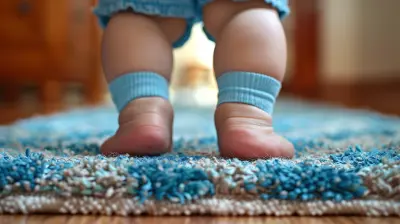Navigating Peer Pressure: Helping Your Child Make Wise Choices
10 August 2025
Peer pressure is an inevitable part of growing up. Whether it’s pressure to dress a certain way, behave a certain way, or participate in activities they wouldn’t normally consider, kids face tough choices daily. As parents, we can’t shield them from every situation, but we can equip them with the confidence and skills to make their own decisions—decisions that align with their values rather than simply following the crowd.
So, how do we help them navigate peer pressure without hovering over their every move? Let’s break it down. 
Understanding Peer Pressure
Before we can help our kids deal with peer pressure, we need to understand it ourselves. Peer pressure isn’t always about a group of kids pressuring someone into doing something bad. It comes in different forms and isn’t always obvious.Types of Peer Pressure
1. Direct Pressure – When someone explicitly tells or dares your child to do something (e.g., “Just take one puff of this cigarette; don’t be lame!”).2. Indirect Pressure – When your child notices that their friends are all doing something and feels the need to fit in (e.g., buying expensive brands because their peers wear them).
3. Positive Pressure – Not all peer pressure is harmful. Sometimes, friends push each other to try new activities, work harder in school, or make healthier choices.
4. Negative Pressure – The type most parents worry about—when friends encourage risky or harmful behavior like skipping school or sneaking out at night.
Understanding these different forms helps us tailor our approach to guiding our kids. 
Why Peer Pressure Affects Kids So Much
Children and teens crave acceptance. Their brains are still developing, especially the part responsible for impulse control and decision-making. As a result, they often prioritize fitting in over making smart choices—even when they know better.Fear of rejection, desire for social status, and even curiosity play huge roles in their decisions. Talking about these natural feelings with them can help them recognize when they’re being influenced for the wrong reasons. 
How to Prepare Your Child for Peer Pressure
The best way to help your child stand up to peer pressure is to equip them with confidence, critical thinking skills, and a strong sense of self-worth. Here are a few ways to do just that:1. Build Their Self-Confidence
Confidence is like a shield against peer pressure. A child who believes in themselves is less likely to be swayed by negative influences. Encourage your child to take pride in their individuality and reinforce their strengths.- Give them responsibilities that boost their sense of achievement.
- Praise their efforts and not just outcomes.
- Encourage them to engage in hobbies that build their skills and self-esteem.
When kids feel good about themselves, they’re more likely to trust their judgment rather than blindly follow others.
2. Encourage Open Communication
If your child knows they can talk to you without fear of punishment or judgment, they’re more likely to come to you when they face tough situations.- Ask open-ended questions instead of just “yes” or “no” ones. Instead of “Did you have a good day?” try “What was the most interesting part of your day?”
- Share your own experiences with peer pressure—mistakes and all.
- Listen without overreacting. If they fear your reaction, they’ll stop confiding in you.
The goal is to make sure they see you as a safe space, not someone who will just lecture them.
3. Teach Decision-Making Skills
Sometimes, kids give in to peer pressure simply because they don’t know how to say no. Teach them a decision-making process they can rely on:1. Stop and think – Encourage them to pause before saying “yes” to something questionable.
2. Consider consequences – Ask themselves, “What could happen if I go along with this?”
3. Trust their instincts – If something feels wrong, it probably is.
4. Walk away if needed – It’s okay to remove themselves from a situation.
Role-playing different scenarios at home can help them feel prepared when a real situation arises.
4. Help Them Practice Saying No
Saying no isn’t easy, especially when friends are involved. Teach your child different strategies to resist peer pressure gracefully:- Be firm, but kind – “No thanks, I’m good.”
- Use humor – “If I wanted to make bad decisions, I’d just let my little sibling pick my clothes.”
- Blame parents (yes, really!) – “My mom would lose her mind if I did that.”
- Suggest an alternative – “Let’s do something else instead.”
The more they practice, the easier it gets in real life. 
What to Do When Your Child Gives in to Peer Pressure
Even with all the right tools and guidance, mistakes will happen. Instead of reacting with anger or disappointment, use these moments as learning experiences.1. Stay Calm and Avoid Overreacting
If your child confesses to making a bad choice, resist the urge to freak out. If they fear your reaction, they might start hiding things from you in the future.Instead, ask them:
- “What was going through your mind when this happened?”
- “How did you feel afterward?”
- “What can you do differently next time?”
This helps them reflect on their choices instead of just regretting the outcome.
2. Reinforce That Mistakes Don’t Define Them
Everyone messes up. Teach them that one mistake doesn’t make them a bad person. The important thing is learning from it and moving forward.Help them brainstorm ways to repair any harm done and encourage them to forgive themselves.
3. Strengthen Their Support System
If your child is repeatedly giving in to negative peer pressure, look at their social circle. Sometimes, the best solution is finding new friends who share their values.Encourage them to be around people who:
- Respect their choices
- Encourage positive behavior
- Support their goals and interests
If they struggle socially, help them find clubs, sports teams, or hobbies where they can meet like-minded peers.
Being the Role Model They Need
Kids are always watching. If they see you bowing to peer pressure—whether it’s overspending to impress friends or agreeing to things you don’t believe in—they’ll learn to do the same.Model the behavior you want them to adopt by:
- Standing up for your values even when it’s unpopular.
- Saying no to things that don’t align with your priorities.
- Choosing friendships carefully and avoiding toxic relationships.
When they see you making wise choices despite outside influence, they’ll be more likely to follow suit.
Final Thoughts
Navigating peer pressure is tough, but you don’t have to do it alone. By building your child’s confidence, encouraging open communication, and giving them practical strategies, you empower them to make decisions they’re proud of.Remember, the goal isn’t to shield them from every bad influence—it’s to equip them with the skills they need to stand strong in the face of pressure. With your support, they’ll learn that fitting in is never as important as being true to themselves.
all images in this post were generated using AI tools
Category:
Parenting SupportAuthor:

Tara Henson
Discussion
rate this article
1 comments
Zailyn Rogers
Great tips! Empowering kids to navigate peer pressure is so essential!
August 22, 2025 at 4:35 PM

Tara Henson
Thank you! Empowering children is key to their resilience and decision-making. I'm glad you found the tips helpful!


